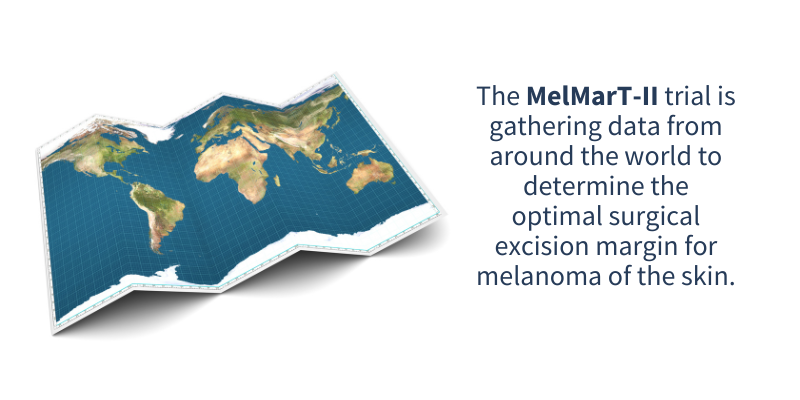Despite melanoma’s prevalence around the world, there is no consensus in the international medical community to guide how much skin should be removed around the cancer to avoid disfigurement and reduce the risk of the melanoma returning and metastasising.
An Australian-led trial is now gathering melanoma experts from around the world to contribute results from 3,000 patients to determine the optimal surgical excision margin for melanoma of the skin.
With its international focus, the MelMarT-II trial has already enrolled over 600 patients at 33 hospitals in seven different countries, representing some of the highest melanoma rates in the world.
Boosting this international effort is the recent activation of the trial within the USA’s National Cancer Institute’s National Clinical Trials Network (NCI-NCTN) through the SWOG cooperative group (collaborating with four other national cooperative groups). This development will allow for an anticipated inclusion of approximately 50 sites across the USA, adding to the trial’s existing six US sites.
The trial’s UK collaborators have also extended their reach, with nine sites now open across the country. Another trial site will soon open at the Institute of Oncology, Ljubljana, Slovenia, which is one of the top 10 of countries for melanoma. These countries are joined by collaborators from Canada, Sweden, The Netherlands and New Zealand.

SWOG Cancer Research Network’s Dr Joshua Mammen said the international collaboration was an exciting opportunity to contribute to a trial that would guide the management of melanoma for patients world-wide.
“The surgical excision of a melanoma can be incredibly disfiguring depending on the location of the cancer, so we urgently need consensus on the optimal excision margin that reduces the risk of the melanoma returning while preserving the patient’s quality of life as much as possible,” Dr Mammen said.
“The rates of melanoma in the USA have been rapidly rising over the past few decades, so our contribution to the trial will improve treatment outcomes for the growing number of Americans affected by melanoma, as well as patients in other countries with high melanoma rates,” he added.
The trial’s UK-based Co-Chief Investigator, Prof Marc Moncrieff, said the UK had around 16,700 new melanoma cases every year and it was the UK’s fifth most common cancer.
“Melanoma does not discriminate and can affect the young and old living anywhere in the world, so this trial will give us the high-quality data needed for a consensus in melanoma management to inform the international medical community,” Prof Moncrieff said.
“Working with Prof Michael Henderson, the trial’s Australian Co-Chief Investigator, and our other international collaborators, also provides opportunities to learn from our peers about complex melanoma surgical cases,” he added.
Led by Melanoma and Skin Cancer Trials, the Australian national collaborative trials group for melanoma and skin cancer, this phase III randomised controlled surgical trial will study the disease-free survival rates for patients treated with either a 1cm or 2cm excision margin for stage II primary cutaneous melanoma.
For more information on the MelMarT-II trial, including hospitals that are enrolling participants, click here.
MelMarT-II Co-Chief Investigators: Prof Michael Henderson, Peter MacCallum Cancer Centre, Australia and Prof Marc Moncrieff, Norfolk & Norwich University Hospital, UK


